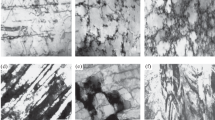Abstract
Deviations from Matthiessen's rule (MR) in cold-worked Cu samples have been measured as a function of temperature between 4°K and room temperature. They can amount up to 100% of the residual resistivity. A second group of measurements concerns deviation from the additivity of the residual resistivities that arise in the deformed specimens when point defects are added at 4.6° K during a neutron irradiation. In a third group of experiments we investigated deviations from MR as a function of temperature in undeformed Cu samples that have been neutron irradiated at 4.6°K and annealed at different temperatures. There are two essential reasons for these deviations: (1) Defects can change the vibrational behavior of the lattice and so alter the temperature-dependent part of the electrical resistivity. The additional resistivity is found experimentally and theoretically to depend asT 5 on temperature at low temperatures. (2) Anisotropies in the Fermi surface of Cu and in the scattering potentials of the defects give rise to deviations from MR. These deviations can be described by a two-band model for the conduction electrons. Within the framework of this model we were able to describe the deviations that were measured in the deformed Cu samples and in Cu alloys (earlier experiments) in a consistent way, using the same parameters (ratio τ N /τ B of the relaxation times for the neck and belly of the Fermi surface) for the two-band model. Furthermore we could show that the enhanced resistivity increase during neutron irradiation observed in deformed Cu samples is not the consequence of an enhanced defect production rate but that it is a result of deviations from MR due to the different scattering behavior of the defects induced by irradiation and cold work. Measurements of the longitudinal magnetoresistance of the deformed and irradiated copper samples give additional information about the scattering anisotropy of the defects and therefore allow for separating the contributions of the two types of defects the combination of which causes deviations from MR.
Similar content being viewed by others
References
B. Lengeler, W. Schilling, and H. Wenzl,J. Low Temp. Phys. 2, 59 (1970).
J. E. Bailey,Electron Microscope Observations on Recovery and Recrystallization Processes in Cold-worked Metals, from G. Thomaset al., Electron Microscopy and Strength of Crystals (Interscience, Publishing Co., New York, 1963).
H. D. Mengelberg, M. Meixner, and K. Lücke,Acta Met. 13, 835 (1965).
K. Fischer,Phys. Kondensierten Materie 6, 171 (1967).
J. M. Welter, thesis, Technische Hochschule, München, 1969.
P. R. Swann, “Dislocation Arrangement in Face-Centered Cubic Metals and Alloys,” from G. Thomaset al., Electron Microscopy and Strength of Crystals (Interscience Publishing, New York, 1963).
T. W. Barbee, R. A. Huggins, and W. A. Little,Phil. Mag. 14, 255 (1966).
W. Sassin, thesis, Technische Hochschule, Aachen, 1969.
W. Schilling, “Annealing Stages in the Electrical Resistivity of Irradiated F.C.C. Metals,” in J. Diehl, W. Schilling, D. Schumacher, and A. Seeger,Vacancies and Interstitials in Metals (North Holland Publishing Co., Amsterdam, 1969).
H. Wenzl, “Physical Properties of Point Defects in Metals,” in J. Diehl, W. Schilling, D. Schumacher, and A. Seeger,Vacancies and Interstitials in Metals (North Holland Publishing Co., Amsterdam, 1969).
J. M. Ziman,Principles of the Theory of Solids (Cambridge University Press, 1965).
R. Losehand, F. Rau, and H. Wenzl,Radiation Effects (in print).
J. S. Dugdale and Z. S. Basinski,Phys. Rev. 157, 552 (1967).
J. M. Ziman,Phys. Rev. 121, 1320 (1961).
J. S. Dugdale and L. D. Firth,Phys. Kondensierten Materie 9, 54 (1969).
R. D. Barnard, J. E. A. Alderson, T. Farrell, and C. M. Hurd,Phys. Rev. 176, 761 (1968).
J. M. Templeton, P. T. Coleridge, and L. F. Chollet,Phys. Kondensierten Materie 9, 21 (1969).
Author information
Authors and Affiliations
Rights and permissions
About this article
Cite this article
Lengeler, B., Schilling, W. & Wenzl, H. Deviations from Matthiessen's rule and longitudinal magnetoresistance in cold-worked and neutron-irradiated copper. J Low Temp Phys 2, 237–254 (1970). https://doi.org/10.1007/BF00628179
Received:
Issue Date:
DOI: https://doi.org/10.1007/BF00628179




